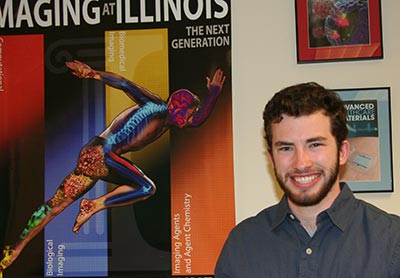Since 2014, Currier has worked with Mariana Kersh, assistant professor in mechanical science and engineering and a Beckman affiliate faculty member in the Bioimaging Science and Technology Group.
Bone Strength

Currier’s research goal is to study the effects of macro- and microstructures on the strength of bone.
“Macrostructure is at the whole bone scale, while microstructures are the smaller structures that make up the bone,” said Currier. “Macrostructure parameters include total bone length, ultimate load, and apparent modulus, or the relation of stress to strain. Microstructure parameters include parameters such as cortical thickness, cortical diameter, porosity, trabecular length, trabecular thickness, and connectivity.” Cortical and trabecular refer to the two types of tissues that form bone.
"If we get a CT scan of a patient’s leg or a hip, we can look at the different structural parameters that are making up the bone, like cortical thickness, cortical diameter, porosity, trabecular length, trabecular thickness, and connectivity. We can then predict if that patient is at risk for osteoporosis." --Eric Currier, graduate student in mechanical science and engineering
To determine this correlation, Currier performs computerized tomography (CT) scans in Beckman’s Microscopy Suite on both un-deformed and deformed mice femurs. He scans the bones and compares the two phases to calculate strain. Currier can apply compression and tension to the specimens using a Deben testing stage as they are simultaneously scanned in three dimensions by the Xradia microCT scanner.
“It’s actually very difficult to get mechanical testing data while in a CT scanner because there’s a lot of x-rays going through and it’s very dangerous, so it has to be closed. It’s very nice to have this Deben testing stage that I can control from the outside,” said Currier. “I couldn’t do my research without this piece of equipment.”
Once he has the images, Currier uses Vic-Volume, a digital volume correlation software, to examine the three-dimensional scans piece by piece or voxel by voxel, comparing the un-deformed to the deformed shapes.
Who is at Risk?
Currier tracks how the voxels change in the un-deformed to deformed phase and then is able to calculate the strain, because of how much a voxel is displaced. Determining the amount of strain allows Currier to correlate the strain to strength and study the bone parameters contributing to the different strain values.
Currier hopes that that his work might one day be used to determine who is at risk to develop osteoporosis.
“As we age, there’s a risk of osteoporosis developing in our bones. With a growing older population, this disease is going to have a bigger impact. If we get a CT scan of a patient’s leg or a hip, we can look at the different structural parameters that are making up the bone, like cortical thickness, cortical diameter, porosity, trabecular length, trabecular thickness, and connectivity. We can then predict if that patient is at risk for osteoporosis,” said Currier.
Doctors can then perform preventative care to avoid injury in the future.
Currier began his education at Bradley University in Peoria, Illinois, where he received his bachelor’s degree in mechanical engineering.
“As an undergraduate at Bradley, I realized that, if I went to graduate school, I wanted a university with larger facilities, more funding, and better resources. This is why I looked at UIUC,” said Currier. “Then Mariana Kersh approached me about tissue biomechanics and I knew that was what I wanted to do. All those opportunities I knew I wanted were at Beckman.”
